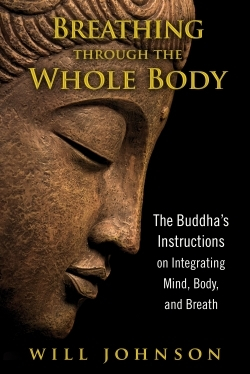Breathing Through the Whole Body
The Buddha's Instructions on Integrating Mind, Body, and Breath
The human body needs more than twenty-one thousand breaths per day, making breathing the most vital requirement for survival. Connecting breath to spiritual insight is a practice across diverse traditions. Here, Will Johnson, author of the award-winning The Spiritual Practices of Rumi, delves into a verse from the Buddhist Satipatthana Sutta to set the stage for sharing concentrated wisdom focused on the breath as a passage into deeper awareness of the body.
“Go to a quiet place in the wilderness,” begins this portion of the Satipatthana Sutta. The book’s surface simplicity yields to deep excavation as Johnson unpacks every word, elaborating with loving compassion the depth of practice and spiritual nurturance possible simply by mindfully exploring all aspects of the breath.
Part one, “The Foundation of the Body,” highlights the requirements of “the upright spine.” Also in part one, two separate chapters balance these polarities: “Solidity and Vibration,” and “Stillness and Motion.” In the latter, the concept of meditator as stone-statue-myth gets revised to “stillness refers only to a quality of mind, not to a rigid and frozen body.” For, in meditation, subtle body movement is actually crucial, with the key being the breath. “Breath wants to liberate itself, to free itself from the encasing and confining prison of the body’s frozen stillness,” says Johnson. Ultimately the movement is about “Letting Go,” examined as the last chapter of part one.
Part two, “The Breath of Unending Motion,” takes readers beyond the basics. Going “into the center,” the author invites them to experience “the entire body [as] an organ of breathing.” Enriching the explanations, his metaphoric archaeological dig reveals the inner reaches of the body.
The longest chapter, “The Koan of Breathing,” includes what readers would commonly expect as the “how-to” details of breathing, meditation, and body awareness, with specific practices to encourage subtle body movements, like “The Breath of the Unfolding Fern,” as a way that “the spine stays in constant resilient motion.”
Some might argue the value of such a slim volume, focused on a single sutta. Yet those willing to follow this path of exploration can access a lifetime of progressive deepening of understanding that grows with focused experience of, and attention to, the breath as it activates the body.
Reviewed by
Bobbye Middendorf
Disclosure: This article is not an endorsement, but a review. The publisher of this book provided free copies of the book to have their book reviewed by a professional reviewer. No fee was paid by the publisher for this review. Foreword Reviews only recommends books that we love. Foreword Magazine, Inc. is disclosing this in accordance with the Federal Trade Commission’s 16 CFR, Part 255.

